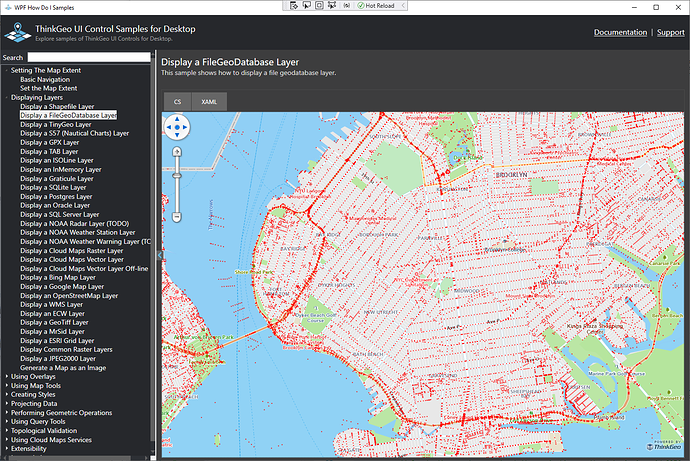Thanks,
The GIS Editor not get update for a while. You can try with the sample
Here is the code to load the data.
private void MapView_Loaded(object sender, RoutedEventArgs e)
{
// It is important to set the map unit first to either feet, meters or decimal degrees.
mapView.MapUnit = GeographyUnit.Meter;
// Create the background world maps using vector tiles requested from the ThinkGeo Cloud Service and add it to the map.
ThinkGeoCloudVectorMapsOverlay thinkGeoCloudVectorMapsOverlay = new ThinkGeoCloudVectorMapsOverlay("itZGOI8oafZwmtxP-XGiMvfWJPPc-dX35DmESmLlQIU~", "bcaCzPpmOG6le2pUz5EAaEKYI-KSMny_WxEAe7gMNQgGeN9sqL12OA~~", ThinkGeoCloudVectorMapsMapType.Light);
mapView.Overlays.Add(thinkGeoCloudVectorMapsOverlay);
// Create a new overlay that will hold our new layer and add it to the map.
LayerOverlay fileGeoDatabaseOverlay = new LayerOverlay();
mapView.Overlays.Add("overlay", fileGeoDatabaseOverlay);
// Create the new layer and set the projection as the data is in srid 2276 and our background is srid 3857 (spherical mercator).
FileGeoDatabaseFeatureLayer fileGeoDatabaseFeatureLayer = new FileGeoDatabaseFeatureLayer(@"C:\Users\FrankFu\Downloads\1\lion\lion.gdb");
fileGeoDatabaseFeatureLayer.FeatureSource.ProjectionConverter = new ProjectionConverter(2263, 3857);
fileGeoDatabaseFeatureLayer.ActiveLayer = "node"; // lion
// Add the layer to the overlay we created earlier.
fileGeoDatabaseOverlay.Layers.Add("Zoning", fileGeoDatabaseFeatureLayer);
// Create an Area style on zoom level 1 and then apply it to all zoom levels up to 20.
fileGeoDatabaseFeatureLayer.ZoomLevelSet.ZoomLevel01.DefaultAreaStyle = new AreaStyle(GeoPens.Black, new GeoSolidBrush(new GeoColor(50, GeoColors.Blue)));
fileGeoDatabaseFeatureLayer.ZoomLevelSet.ZoomLevel01.DefaultPointStyle = new PointStyle(PointSymbolType.Circle, 2 , new GeoSolidBrush(GeoColors.Red));
fileGeoDatabaseFeatureLayer.ZoomLevelSet.ZoomLevel01.ApplyUntilZoomLevel = ApplyUntilZoomLevel.Level20;
// Open the layer and set the map view current extent to the bounding box of the layer.
fileGeoDatabaseFeatureLayer.Open();
mapView.CurrentExtent = fileGeoDatabaseFeatureLayer.GetBoundingBox();
//Refresh the map.
mapView.Refresh();
}
You will get something like this one.
If you display all items at a very high level. It may slow.
You could use this smaple
https://gitlab.com/thinkgeo/public/thinkgeo-desktop-maps/-/blob/master/samples/wpf/HowDoISample/Samples/CreatingStyles/CreateClusterPointStyleSample.xaml.cs to cluster the points.
Thanks
Frank

